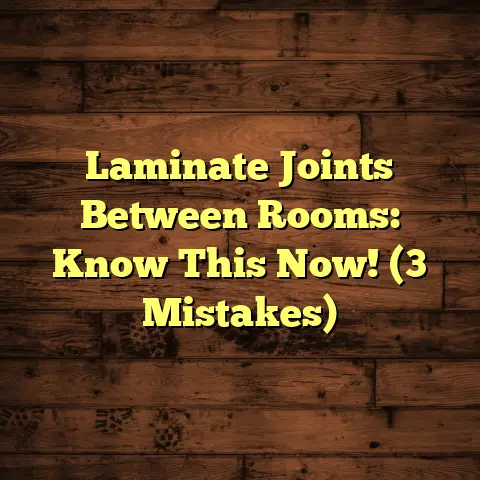Fix Oak Floor Scratches Now! (2 Minute Fix?)
It’s a material I deeply respect.
Let’s dive into the world of oak flooring, explore how to tackle those pesky scratches, and keep your floors looking their best.
A Historical Reference to Wood Flooring
Think back to those grand 18th-century European estates. What do you picture? I bet those images include stunning interiors, often featuring meticulously laid oak floors.
Oak wasn’t just a flooring choice; it was a statement. A symbol of wealth, durability, and craftsmanship. These floors weren’t just walked on; they were lived on, witnessing history unfold with every creak and grain.
Even today, oak remains a popular choice. Its timeless appeal and resilience continue to captivate homeowners and builders alike. But let’s be honest, life happens, and with it come scratches.
Those inevitable marks that can mar the beauty of your beautiful oak floor. Don’t worry, though! I’m here to guide you through understanding, fixing, and preventing them.
Section 1: Understanding Oak Flooring
Before we jump into fixing scratches, let’s understand what makes oak so special. It’s not just any wood; it has distinct characteristics that set it apart.
1.1. Characteristics of Oak Wood
Oak is known for its hardness and durability. On the Janka hardness scale, which measures the resistance of wood to denting and wear, oak scores pretty high.
- Red Oak: Typically scores around 1290.
- White Oak: Usually scores around 1360.
This means it can withstand a fair amount of foot traffic, furniture movement, and the occasional dropped object. But not all oak is created equal.
We commonly see red oak and white oak used for flooring. Red oak has a slightly pinkish hue and a more open grain. White oak has a warmer, beige tone and a tighter grain.
White oak is also more water-resistant than red oak, making it a better choice for areas prone to moisture. These differences affect not only the appearance but also the performance and longevity of your floor.
1.2. Common Uses of Oak Flooring
Oak flooring is incredibly versatile. I’ve installed it in everything from cozy residential homes to bustling commercial spaces and even historical buildings.
Its popularity spans various architectural styles. From rustic farmhouses to sleek modern lofts, oak can seamlessly blend into any design aesthetic. In residential homes, you’ll often find oak in living rooms,
dining rooms, and bedrooms. Its durability makes it a great choice for high-traffic areas, while its natural beauty adds warmth and character to any space. Commercial spaces, like offices and retail stores,
also benefit from oak’s durability and aesthetic appeal. Historical buildings often feature original oak floors, a testament to the wood’s longevity and timelessness. It’s a choice that bridges the past and the present.
Section 2: The Inevitable Scratches
No matter how careful you are, scratches happen. It’s just a part of life with oak floors. But understanding what causes them and how they impact your floor’s appearance is crucial.
2.1. Causes of Scratches on Oak Floors
Think about your daily routine. What could be causing those scratches? Here are some common culprits I see all the time:
- Pet Claws: Our furry friends can unintentionally scratch floors with their claws, especially when they get excited.
- Furniture Movement: Dragging furniture, even slightly, can leave noticeable scratches, especially if the furniture legs aren’t properly protected.
- Everyday Wear and Tear: Shoes, dropped objects, and general foot traffic can gradually wear down the finish and cause minor scratches over time.
- Environmental Factors: Humidity and temperature changes can cause wood to expand and contract. This can weaken the finish and make it more susceptible to scratches.
I’ve seen cases where high heels have left their mark, kids’ toys have taken a toll, and even a rogue pebble stuck to the bottom of a shoe has caused damage. It’s a constant battle, but knowing the enemy helps!
2.2. Impact of Scratches on Aesthetics and Value
Scratches can significantly impact the overall appearance of your oak flooring. They can make the floor look dull, worn, and uncared for.
Even minor scratches can detract from the natural beauty of the wood, especially if they’re in a high-traffic area. But the impact goes beyond just aesthetics.
Scratches can also affect your property value and buyer perception. A scratched-up floor can give potential buyers the impression that the home hasn’t been well-maintained. This can lead to lower offers or even deter buyers altogether.
According to a 2023 survey by the National Association of Realtors (NAR), homes with well-maintained hardwood floors tend to sell for approximately 2.5% more than comparable homes with damaged or poorly maintained floors.
Think of it this way: your floors are a reflection of your home. Taking care of them shows that you care about the details, which can make a big difference in the eyes of a buyer.
Section 3: Quick Fixes for Oak Floor Scratches
Alright, let’s get to the good stuff – fixing those scratches! I’m going to share some quick and easy DIY solutions that can help restore your oak floors to their former glory.
3.1. Immediate Solutions for Minor Scratches
For those super minor, barely-there scratches, you might be surprised at how simple the fix can be. Here’s my go-to two-minute trick:
- The Walnut/Almond Rub: Grab a walnut or almond from your pantry. Rub the nut over the scratch, applying gentle pressure. The natural oils in the nut will help to fill in the scratch and blend it with the surrounding wood. Wipe away any excess oil with a soft cloth.
It sounds crazy, but it works! The oils and natural color of the nut help to disguise the scratch. I’ve used this trick on countless floors with great success.
Another option is to use wood markers or crayons that match the oak finish. These are readily available at most hardware stores and are super easy to use.
Simply color in the scratch with the marker or crayon, and then wipe away any excess with a clean cloth. Make sure to choose a color that closely matches your floor’s finish for the best results.
3.2. DIY Repair Techniques for Deeper Scratches
For deeper scratches that go beyond the surface finish, you’ll need to step up your game a bit. Here are a couple of methods I recommend:
-
Wood Filler: This is a great option for filling in deeper scratches and gouges. Choose a wood filler that matches the color of your oak floor.
Apply the filler to the scratch using a putty knife, making sure to overfill slightly. Allow the filler to dry completely according to the manufacturer’s instructions.
Once dry, sand the area smooth with fine-grit sandpaper (220-grit or higher). Be careful not to sand too much, as you don’t want to damage the surrounding finish. Finally, apply a matching stain or finish to the filled area.
-
Wood Stain Pen: A wood stain pen can be used to conceal deeper scratches and blend them with the surrounding wood. Choose a stain pen that matches the color of your oak floor.
Apply the stain to the scratch, following the grain of the wood. Wipe away any excess stain with a clean cloth. Allow the stain to dry completely before applying a clear finish to protect the repaired area.
For small areas, you can even consider sanding and refinishing. Here’s a quick rundown:
- Prep the Area: Clean the area thoroughly and tape off the surrounding floor to protect it.
- Sand the Scratch: Use fine-grit sandpaper to gently sand the scratched area, feathering the edges to blend it with the surrounding finish.
- Apply Stain (if needed): If the sanding removed the stain, apply a matching stain to the sanded area.
- Apply Finish: Apply a clear finish (like polyurethane) to the repaired area, following the manufacturer’s instructions. You may need to apply multiple coats for the best protection.
Safety First! Always wear a dust mask and eye protection when sanding. And make sure to work in a well-ventilated area.
Section 4: Preventative Measures for Oak Flooring
Prevention is always better than cure! Taking proactive steps to protect your oak floors can save you a lot of time and effort in the long run.
4.1. Routine Maintenance Tips
Regular cleaning and maintenance are key to preventing scratches and keeping your oak floors looking their best. Here are some tips I always share:
- Sweep or Vacuum Regularly: Use a soft-bristled broom or a vacuum with a floor brush attachment to remove dirt, dust, and debris that can scratch the finish. I recommend doing this at least once a week, or more frequently in high-traffic areas.
- Use Area Rugs: Place area rugs in high-traffic areas, such as entryways, hallways, and living rooms, to protect the floors from scratches and wear.
- Felt Pads Under Furniture: Attach felt pads to the legs of all your furniture to prevent scratches when moving or rearranging furniture. This is a simple but effective way to protect your floors.
- Trim Pet’s Nails: Keep your pet’s nails trimmed to minimize the risk of scratches. Regular grooming can make a big difference.
4.2. Choosing the Right Cleaning Products
Using the wrong cleaning products can damage the finish of your oak floors and make them more susceptible to scratches. Here are some do’s and don’ts:
Do:
- Use a pH-Neutral Cleaner: Choose a cleaner that is specifically designed for hardwood floors and has a neutral pH. This will help to protect the finish and prevent damage.
- Use a Microfiber Mop: Microfiber mops are gentle on hardwood floors and effectively remove dirt and debris.
- Damp Mop, Not Wet Mop: Always wring out your mop thoroughly before mopping your oak floors. Excess water can damage the wood and cause it to warp or swell.
Don’t:
- Use Harsh Chemicals: Avoid using harsh chemicals, such as bleach, ammonia, or vinegar, as these can damage the finish and discolor the wood.
- Use Abrasive Cleaners: Don’t use abrasive cleaners or scouring pads, as these can scratch the finish.
- Steam Mop: Avoid using steam mops on oak floors, as the heat and moisture can damage the wood.
Recommended Cleaning Products:
- Bona Hardwood Floor Cleaner
- Murphy Oil Soap (diluted)
- Method Squirt + Mop Hardwood Floor Cleaner
Section 5: When to Seek Professional Help
Sometimes, DIY fixes just aren’t enough. There are situations where it’s best to call in the professionals to ensure the job is done right.
5.1. Signs that a Professional is Needed
Here are some signs that it’s time to seek professional help:
- Extensive Damage: If your oak floors have extensive damage, such as deep scratches, gouges, or water damage, it’s best to hire a professional to repair or replace the damaged sections.
- Uneven Planks: If your oak floors have uneven planks or are cupping (where the edges of the planks are higher than the center), it could be a sign of moisture damage or improper installation. A professional can assess the situation and recommend the appropriate course of action.
- Refinishing Needed: If your oak floors are looking dull, worn, or have significant scratches, it may be time to refinish them. Refinishing involves sanding down the existing finish and applying a new coat of stain and finish. This is a complex process that requires specialized equipment and expertise.
- DIY Attempts Failed: If you’ve tried DIY fixes and they haven’t worked, it’s best to call a professional to avoid further damage.
5.2. Selecting a Flooring Specialist
Choosing the right flooring professional is crucial to ensuring that the job is done correctly and to your satisfaction. Here’s some advice:
- Check Reviews and References: Look for online reviews and ask for references from previous clients. This will give you an idea of the professional’s reputation and quality of work.
- Get Multiple Estimates: Get estimates from at least three different flooring professionals. Compare the estimates carefully, taking into account the scope of work, materials, and labor costs.
- Ask About Experience and Qualifications: Ask the flooring professional about their experience and qualifications. Make sure they are licensed and insured, and that they have experience working with oak floors.
- Ask About the Process: Ask the flooring professional to explain the repair or refinishing process in detail. This will help you understand what to expect and ensure that they are using the appropriate techniques and materials.
- Get a Written Contract: Make sure to get a written contract that outlines the scope of work, materials, labor costs, and payment schedule. This will protect you in case of any disputes.
Conclusion: Embracing the Beauty of Oak Flooring
Oak flooring is a timeless investment that can add beauty, value, and character to your home. While scratches are inevitable, they don’t have to ruin the overall appearance of your floors.
By understanding the characteristics of oak, taking preventative measures, and using the appropriate repair techniques, you can keep your oak floors looking their best for years to come.
Embrace the character that comes with natural wood. Those minor imperfections tell a story, adding warmth and authenticity to your home. With proper care and maintenance, your oak floors will continue to enhance the charm of your space for generations to come.
Remember, a well-maintained oak floor is more than just a surface to walk on; it’s a foundation for memories, a testament to enduring quality, and a reflection of your commitment to creating a beautiful and welcoming home. So, go ahead, fix those scratches, and enjoy the timeless beauty of your oak floors!





